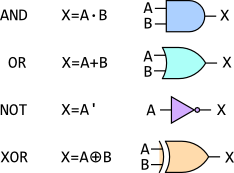Boolean logic
In the 1840s, English mathematician George Boole developed an algebra (a set of operators and laws) for variables that can have just two states – true and false. Thus, a Boolean value is equivalent to one bit:
False = 0 = off
True = 1 = onThe operators defined by Boole are pervasive throughout all of computing. You may have encountered them in doing library or other database searches. The ones we’ll consider are:

The table illustrates both the algebraic notation and the circuit diagram notation. The elements of circuit diagrams are called gates, as in “AND gate” or “XOR gate.”
The behavior of these operators can be defined by truth tables:
A B A·B A+B A' A⊕B
0 0 0 0 1 0
0 1 0 1 1 1
1 0 0 1 0 1
1 1 1 1 0 0We combine the gates into combinational circuits to achieve various effects. For example, the algebraic expression X = A·B + A·C corresponds precisely to the following circuit diagram:

and we can discover its effect by completing the truth table:
A B C D=A·B E=A·C X=D+E
0 0 0 0 0 0
0 0 1 0 0 0
0 1 0 0 0 0
0 1 1 0 0 0
1 0 0 0 0 0
1 0 1 0 1 1
1 1 0 1 0 1
1 1 1 1 1 1Exercise: Try drawing the circuits and the truth tables for X=(A·B)' and for X=A'+B'. They should produce the same result for the inputs A and B. This is one of DeMorgan’s Laws.